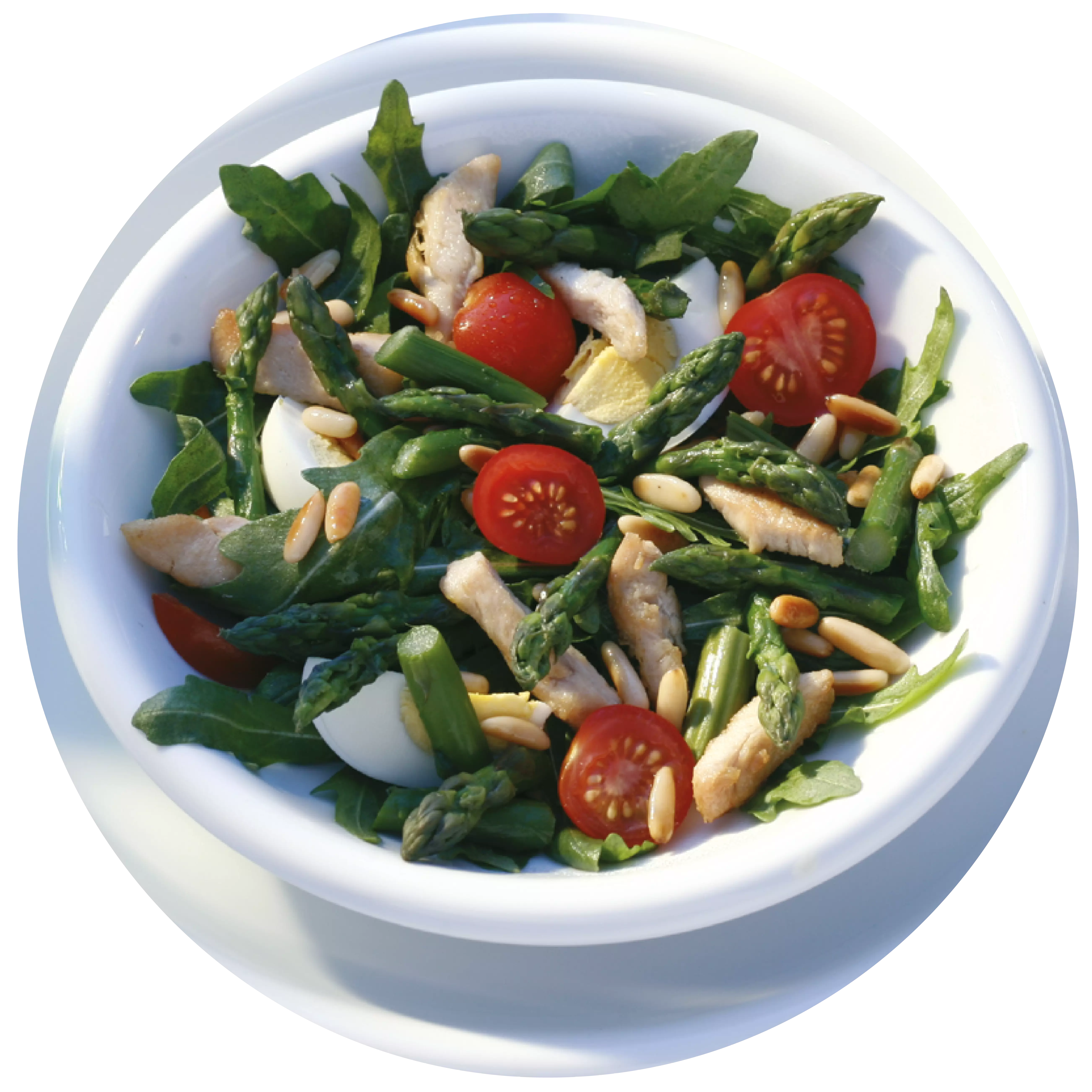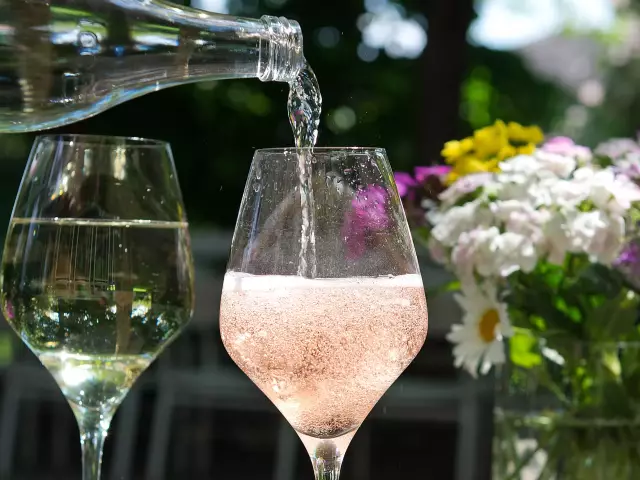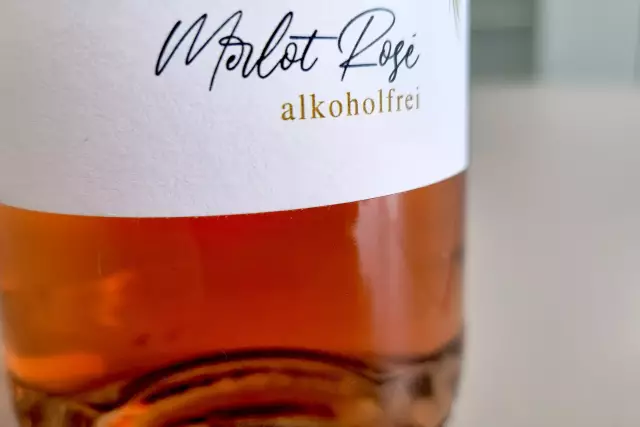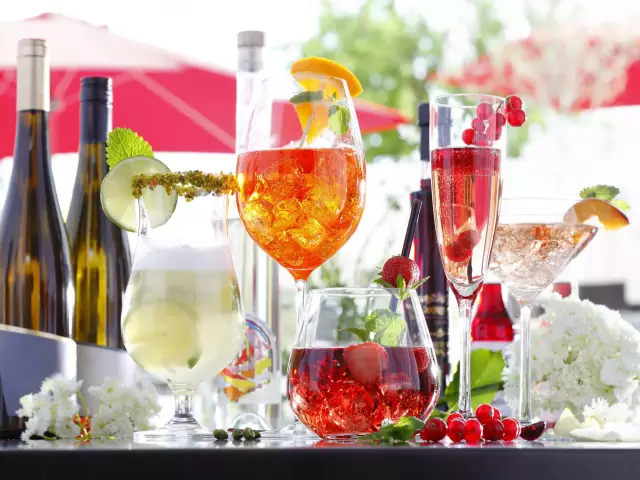Ice Wine
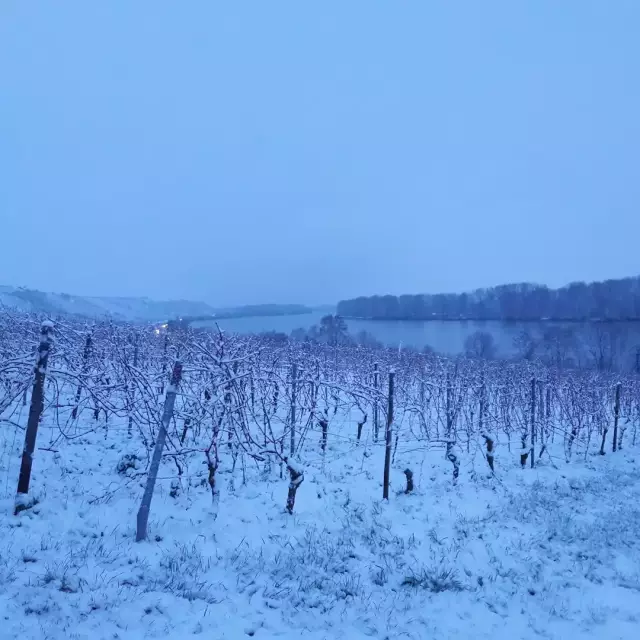
Wenn Winzer pokern, ist der Einsatz hoch. Es geht um Trauben, die länger als sonst üblich am Rebstock hängen bleiben und auf Temperaturen von mindestens -7°C warten.
Facts
-
-7°C
Grapes that hang on the vine longer than usual and wait for temperatures of at least -7°C can be used for ice wine.
-
1830
Ice wine was first documented in 1830, when winemakers in Dromersheim near Bingen in the Rhine-Hesse region accidentally discovered on February 11 that a wonderfully sweet must could be made from frozen grapes.
-
100
German ice wines usually have very high natural residual sugar contents of well over 100 grams per liter
Ice wine - a winemaker's gamble
In some years, precious rarities reward winemakers' willingness to take risks. When winemakers play such poker, the stakes are high. It's about grapes that stay on the vine longer than usual and wait for temperatures of at least -7 ° C. The winemaker's game with nature can last until January, and in rare cases until February. For the winemaker, it is all or nothing, because the ‘ice wine poker’ carries the risk of total loss.
If it doesn't get cold enough, ice wine cannot be produced. Only about 5-10% of the original harvest quantity is bottled as ice wine on average. The remaining amount of grapes is selectively cut out or falls victim to the unpredictable weather conditions.
The winemaker's masterpiece
The actual ice wine harvest, which in the vast majority of cases takes place in the early morning hours, is exhausting. The cold makes the fingers rigid and sensitive to pain. The frozen berries are laboriously harvested, and in the end the harvest quantity is often only between 300 and 500 liters per hectare. Nevertheless, the production of an ice wine is a challenge that a winery likes to face because this specialty is always seen as a masterpiece of the winemaker, which can only be produced in northern wine regions.
These requirements make things exciting not only for the winemaker but also for ice wine fans from all over the world who keep looking at the thermometer from the start of the harvest, hoping for a cold snap. The wine, which is produced as a rarity right from the start, draws collectors to the scene. High prices are asked for these noble treasures and the few available bottles are always in high demand.
The berry must freeze on the vine
It has been known since the very beginning of viticulture that minus degrees can be helpful in wine production. As early as 44 AD, the Roman writer Pliny reported on wines made from frozen grapes. In Germany, ice wine is documented for the first time in 1830, when winegrowers in Dromerheim near Bingen in Rhineland-Hesse accidentally discovered on February 11 that a wonderfully sweet must could be obtained from frozen grapes. With an amendment to the German Wine Law in 1982, "Eiswein" was raised to an independent attribute with corresponding regulations for berry selection, such as a minimum must weight of 110 to 128 ° Oechsle, depending on the growing region.
In contrast to the other noble sweet wines such as Auslesen, Beerenauslesen and Trockenbeerenauslesen, the secret of ice wine lies in the dense concentration of the berry ingredients and a comparatively high degree of acidity. This phenomenon is achieved by freezing the berries on the vine. At least -7 ° C is required before the ice wine grapes can be harvested, ideally it is -10 to -12 ° C. The naturally frozen grapes are pressed in this “icy” condition early in the winter morning. The water contained in the berries remains as ice on the wine press, while only the sweetest juice, whose freezing point is lower than that of water, is obtained as a highly concentrated must.
The yeasts have great difficulty fermenting must with such a high sugar content to wine. Therefore, German ice wines generally have a very high natural residual sugar content of well over 100 grams per liter, but in contrast to southern sweet wines, they only have a relatively low alcohol content - often only around 7% by volume.
A premium ice wine needs healthy grapes
Passionate ice wine growers pay close attention to a healthy harvest without botrytis, which is responsible for the so-called noble rot. A premium ice wine needs above all healthy grapes as a starting material and this is exactly where the taste differs from other noble sweet wines such as Beerenauslesen and Trockenbeerenauslesen. A high-quality ice wine does not have the taste characteristics of noble rot. Rather, the healthy grapes guarantee a fresh and concentrated fruity taste, and the wines generally have a relatively stable acidity. Ice wines are therefore a pleasure even at a young age.
The culmination of a culinary evening
Ice wine is a grandiose companion for festive occasions and an excellent aperitif that will delight gourmets. When the meal is completed, ice wine promises a brilliant finish: One can follow the recommendation of ‘like complements like’, especially with fruity desserts, ice cream or sorbets.
Or alternatively, follow the recommendation that ‘opposites attract’. An interesting contrast, even if it may sound unbelievable at first, is enjoying ice wine with mature fine cheese: on the one hand the salty to slightly bitter notes of the creamy cheese, on the other hand the fruity-sweet aromas of the concentrated wine, both contrasting flavors enveloping the palate and tongue, offering an exceptional taste experience.
Why and how are grapes protected that are left hanging for ice wine?
The ice wine plots are partially defoliated and wrapped in film. This process is primarily used to protect the fully ripe grapes from being eaten by birds and was first used in the 1960s. Without the film protection, no grapes would remain on the vine until December or January.
Varietals

More recipe ideas
Light and fluffy: cashew coconut mousse with passion fruit Cashew coconut mousse with passion fruit
An airy cashew coconut mousse with passion fruit
- 400g Cashewkerne
- 400ml Haferdrink
- 6EL Agavendicksaft
- 6EL Kokosflocken
- 4 Passionsfrüchte
- 1 Prise Vanille
Place the cashews in a container and add enough water to cover the cashews sufficiently. Place the cashews in the fridge to soak overnight.
(With a high-performance blender, 3-4 hours is also sufficient.)
Drain the water and place the cashews in the blender with the oat milk, agave syrup and coconut flakes. Add the vanilla and blend until the mousse is creamy and no longer contains any chunks.
<p
<p>Divide the mousse between four glasses. Halve the passion fruit, scrape out the flesh with a teaspoon and place on top of the mousse. Decorate with coconut flakes.
- Pinot Blanc (süß & edelsüß)
- Riesling (süß & edelsüß)
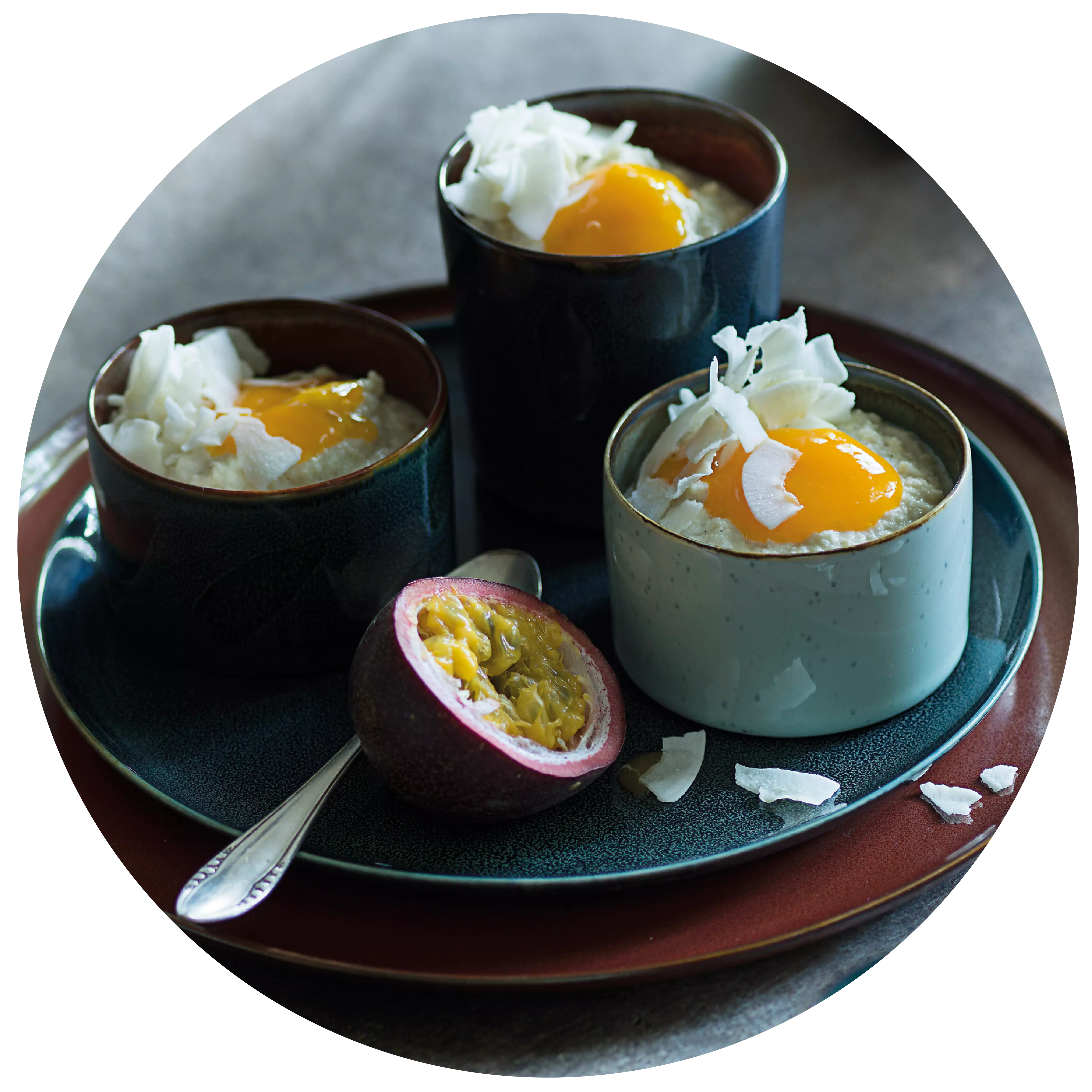
with dry sparkling wine Sparkling wine and lime dessert
with dry sparkling wine
- 300ml Winzersekt
- 4 Limetten
- 100g Zucker
- 30g Speisestärke
- 100g Butterkekse
- 50g ungesalzene Butter
- 2 Eiweiße
- 50g grieschicher Joghurt
- 150g Schlagsahne
Pour the sparkling wine and sugar into a pan. Chill the remaining sparkling wine. Wash 1 lime with hot water and finely grate the zest. Halve the lime and 2 others, squeeze out the juice and mix with the cornflour. Pour everything into the pan and bring to the boil briefly. Remove the pan from the heat and chill the cream in the fridge.
Fill the shortbread biscuits into a freezer bag, crush with a rolling pin and place in a bowl. Melt the butter in a pan, pour over the crumbled shortbread biscuits, add a pinch of salt and mix well. Leave to cool briefly, divide half into large wine glasses and press down firmly.
Cut the lime into slices. Beat the egg whites with salt until stiff. Stir the yoghurt into the chilled champagne and lime cream. Whip the cream until stiff and fold into the cooled cream, one after the other, together with the beaten egg whites. Spread half over wine glasses, add another layer of shortbread biscuits and finish with a layer of cream. Garnish with lime slices and pour in the remaining sparkling wine. Toast and enjoy!
- Riesling (trocken)
- Pinot Blanc (trocken)
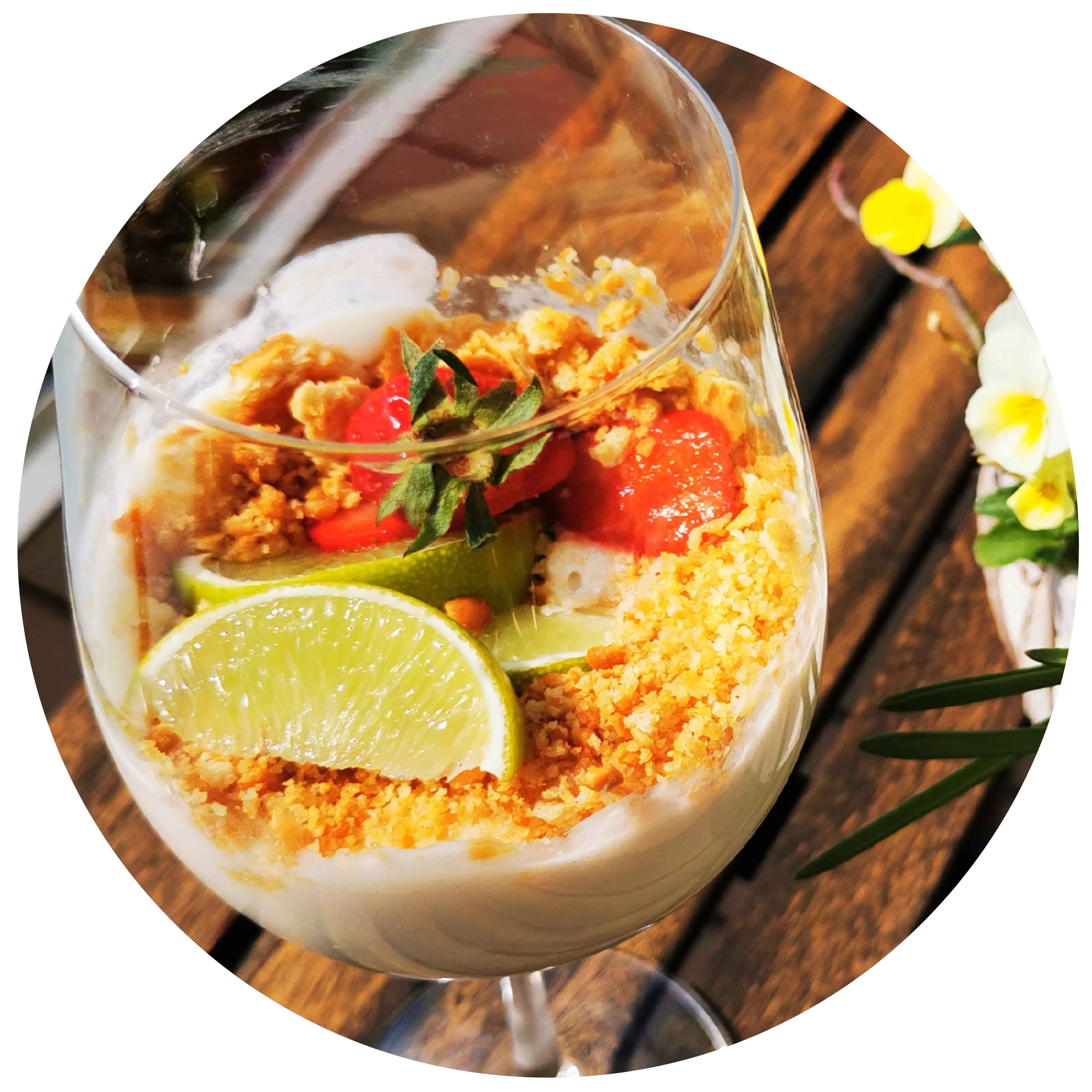
Japanese hollandaise succeeds with wasabi paste Salmon with Japanese hollandaise and green asparagus
Combine salmon with hollandaise and asparagus with a dry Riesling.
- 4x 150g Lachsfilet mit Haut
- 1 Limette
- 2 Zehen Knoblauch
- 4 EL Honig
- 10 EL Sojasauce
- 200g Butter
- 4 Eier
- 1 EL Joghurt
- 2 EL Reisessig
- 2 EL Wasabipaste
- 500 g Grüner Spargel
For the marinade, finely chop the garlic first. Wash the lime in hot water, grate the zest and squeeze out the juice and bring everything to the boil with the honey and soya sauce. Put to one side.
Now prepare the Japanese hollandaise: Bring 180g butter to the boil. Place the egg yolks, yoghurt, rice vinegar, wasabi paste and a pinch of salt in a tall measuring jug and mix with a hand blender. Gradually mix the boiling (!) butter into the egg yolks using a hand blender. Season the hollandaise with salt and pepper to taste and keep the measuring jug warm in hot water.
Peel the bottom third of 500 g green asparagus and cut off the ends. Melt 1 tbsp butter in a large pan. Add the asparagus to the pan, pour in 50 ml water and season with salt and pepper. Cover and bring to the boil briefly.
Fry the salmon fillets on the skin side in a little oil for about 4 minutes. Turn the salmon and fry for a further 2 minutes. Then turn again and baste with the marinade. Remove the salmon from the pan and reduce the marinade until thick. Brush the salmon with it. Serve the salmon with the hollandaise and asparagus. Enjoy your meal!
Wine recommendation:
WINE TIP: Dry Rielsing
- Riesling (trocken)
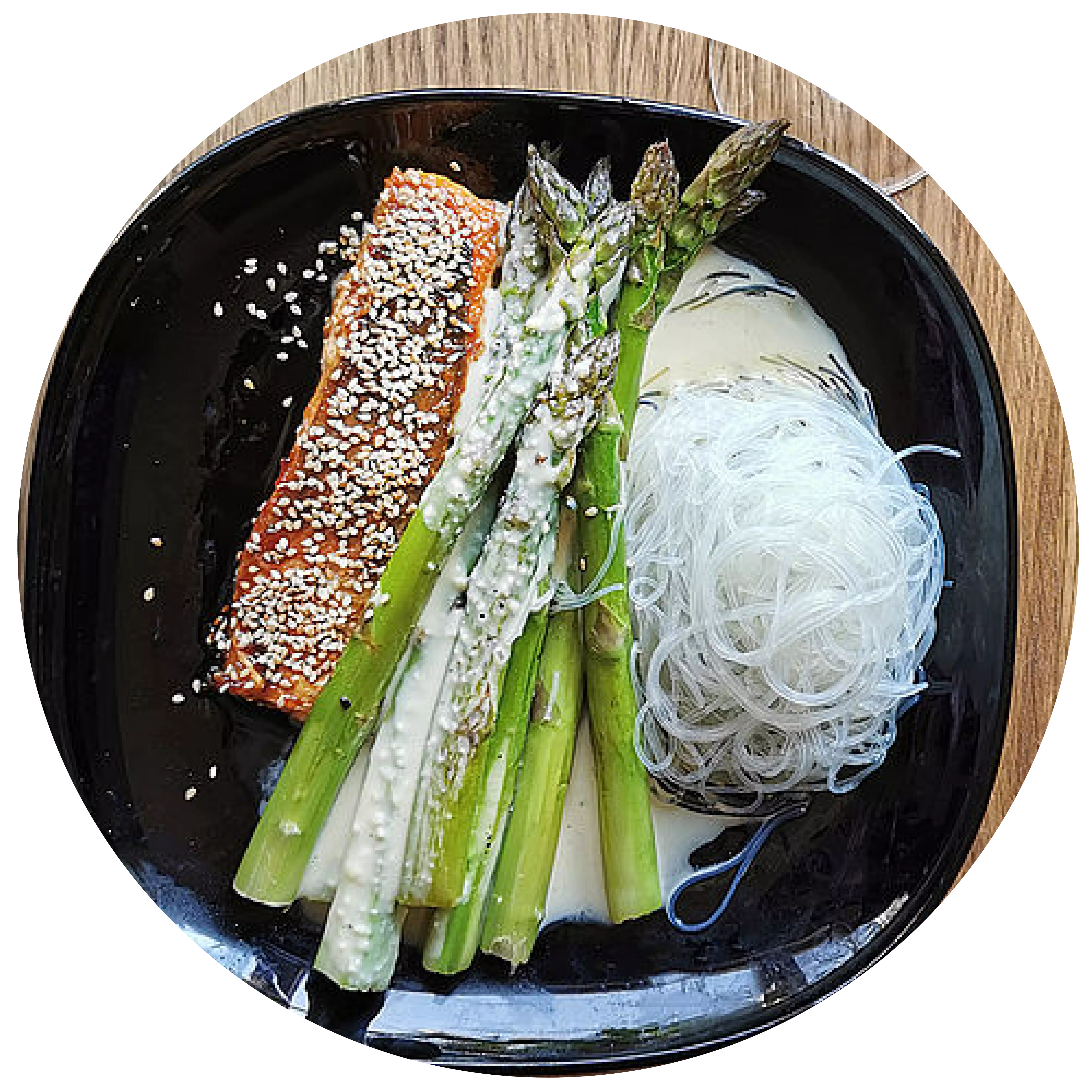
Asparagus again at last Rocket salad with green asparagus and turkey breast fillet
A light, young Rivaner goes well with green asparagus.
- 400g Grüner Spargel
- 100g Rucola
- 400g Putenbrustfilets
- 200g Kirschtomaten
- 4 Eier
- 1 EL Basilikum-Pesto
- 1TL Butter
- 2 EL Olivenöl
- 2 EL Weißwein-Essig
- etwas Salz, Pfeffer
Peel the lower third of the asparagus and cut off the ends. Cut the spears in half and cook in boiling salted water with 1 tsp butter for approx. 7 mins. Set the asparagus water aside.
Cook the eggs until almost firm (the yolk should still be a little soft), peel and cut into quarters. Cut the turkey breast fillet into strips.
Fry the pine nuts briefly without fat in a non-stick pan. Then add a little fat directly to the pan and fry the turkey breast strips. Then keep them warm.
Mix the pesto with the white wine vinegar, 5 tbsp of the asparagus water, the olive oil and salt and pepper in a salad bowl to make a dressing.
Wash the rocket and add to the dressing. Halve the cherry tomatoes and add to the bowl. Mix in the asparagus and turkey. Finally, garnish with the quartered eggs and pine nuts.</p
<p>This goes well with freshly baked ciabatta bread.
Wine recommendation:
A light Rivaner from the last harvest, fresh as spring, with delicate flavours.
- Müller-Thurgau (brut)
